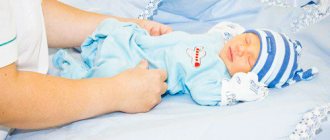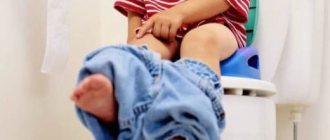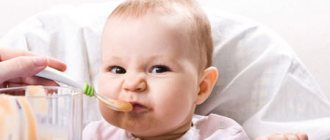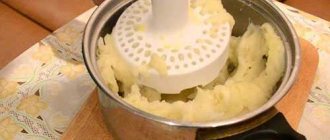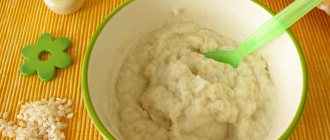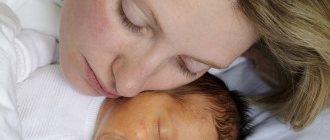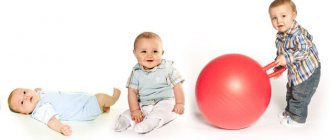What is a rash
A rash is a variety of changes on the skin and mucous membranes that differ from it in color and structure. It is easy to recognize by appearance and touch. Rashes may occur:
- on healthy skin (mucous membrane), they are called primary elements ;
- in place of existing lesions - these are secondary elements .
Various combinations of these elements, supplemented by other symptoms, give a clinical picture characteristic of certain diseases. That is why it is important to pay attention to the nature of the rash, the circumstances of its occurrence and the presence (absence) of other signs. All this information is of great importance when making a diagnosis.
What does an allergy look like on a baby's face?
Most often, allergies manifest themselves in the cheeks, forehead and chin. Rashes may look different and have different structures. In most cases, these are red dry spots of varying sizes. Less commonly, an allergy on the face of a baby manifests itself in the form of small pimples, inside of which there is a watery content.
The rash appears within a few seconds after eating or some time after the skin of the face comes into contact with the allergen. These phenomena disappear after a few days, provided that there is no repeated contact with the allergen.
Simultaneously with the appearance of rashes, the child feels tightness and dryness of the skin, itching and burning appear in the affected area. The baby always strives to scratch the itchy place (this should not be done under any circumstances, so as not to provoke the appearance of ulcers, wounds and their subsequent infection). To protect your child from scratching his face, you should put scratching mittens on his hands.
Often, simultaneously with an allergy on the face, a child experiences allergic rhinitis (runny nose), flatulence, diarrhea, intestinal colic, etc.
Why a rash may appear in an infant
The variety of factors that provoke rashes in infants can be divided into 3 large groups:
- Physiological . For example, hormonal changes in newborns that cause acne.
- Caused by immune response . In this case, the rash may be a response to friction, temperature, or allergens.
- Factors of infectious nature . This includes childhood diseases (rubella, chickenpox, scarlet fever, measles) and other infections (thrush, roseola).
A rash is an obligatory symptom of several dozen diseases, and for several hundred more it is a possible, but not obligatory sign. Therefore, the diagnosis must be carried out by a qualified doctor. Next, we will look at the most common diagnoses that pediatric doctors register today.
How to help a child?
Treatment of rashes in infants should be selected in accordance with the causes that cause them. If the rash is caused by the body’s adaptation to the environment, then actions should include bathing the child more often and following the rules of care. In the case where care is carried out incorrectly, parents must undergo instructions and training from the local pediatrician, who will point out errors in swaddling or observing hygiene rules.
Allergic skin diseases require identifying the allergen itself and eliminating contact with it. During breastfeeding, not only the child, but also the mother should avoid contact with this substance. To eliminate the manifestations of such pathologies, syrups and ointments with antiallergic drugs are used.
Read: Chickenpox in adolescents: causes and consequences
Measles and rubella are caused by a virus and, if developed in newborns, require immediate hospitalization. Scarlet fever is caused by a bacterium and requires antibiotics, since in the absence of timely antibiotic therapy, glomerulonephritis or rheumatism may develop.
Various coccal skin lesions are treated with the use of local antibacterial ointments and daily bathing of the child in baths with herbal disinfectants (for example, chamomile decoction).
Rash not associated with infection
Hormonal rash in a newborn
Another name for this type of rash is neonatal pustulosis . It is considered a physiological phenomenon and occurs in 75% of children. This is a way by which the baby’s body gets rid of excess hormones received from the mother.
When the baby was in the womb, hormones accumulated in his body. After the baby is born, the excess of these hormones causes its sebaceous glands to work intensively. But they are not yet ready for such a load and cope poorly with the increased volume of secretions. As a result, the glands become clogged, and the secretion, instead of coming out, remains inside. This is how milia appear - a special small rash.
But it can be easily confused with other skin changes. For example, with heat rash or food allergies. Therefore, it is useful to know the distinctive signs of a hormonal rash:
- it appears as small red (sometimes pale pink) pimples with a white core ;
- location – face ( forehead, cheeks and nose );
- the affected areas do not become inflamed with proper skin care and careful hygiene.
Treatment. What NOT :
- treat the affected areas with fatty creams, oils, and hormonal-based medications;
- smear the rash with alcohol-based liquids (including brilliant green solution and iodine);
- use herbal infusions for external treatment of rashes;
- try to get rid of the problem with antibiotics;
- use antihistamines and sorbents for treatment;
- cover pimples with powder or talcum powder;
- try to squeeze them out.
The listed methods can cause irreparable harm to the baby and disrupt the normal hormonal development of the body.
What to do then ? In the absence of hyperthermia and signs of infection, pay attention to the general condition of the child. If he eats, sleeps and generally behaves normally, then no special treatment is required. The existing symptoms should disappear in 21–28 days, leaving no traces behind.
But to help your baby, you can and should:
- Monitor the condition of his nails and trim them promptly. It is also useful to wear special mittens (“anti-scratch”) on your hands. Then he will not be able to damage his skin with his nails and cause an infection if the rash causes itching.
- Maintain hygiene and periodically wipe the rash areas with boiled water (its optimal temperature is 35–37 degrees).
- Contact your pediatrician immediately if redness or pus begins to appear.
Contact allergy
Contact allergies often worry the baby. Newborns are too susceptible to synthetics and various chemical components. Children's dishwashing gels, powders and fabric softeners are not a marketing ploy, as many parents think; they contain hypoallergenic components that do not irritate the baby's skin.
A child’s immunity is formed in the first year of life, and before that, many components can cause a rash. If you suspect such changes, you need to reconsider everything that the baby’s skin comes into contact with: from the fabric from which the clothes are made to the powder with which they are washed.
Read more Endometrial polyp without atypia
Often, parents mistake newborn acne or heat rash for an allergic reaction and give their children antihistamines. It must be remembered that any medications are prescribed exclusively by a pediatrician depending on the diagnosis, course of the disease, and test results.
Video: How to distinguish hormonal rashes from allergic ones.
Rashes of allergic etiology
Household allergies (contact dermatitis)
It manifests itself as a rash on the body, which is initially localized in areas of direct contact with the irritant , but then can spread throughout the body. What exactly can a baby’s body react sharply to? As a rule, these are dust, wool, pet saliva, mold, plants, household chemicals, etc. The range of allergens is extremely wide, and each organism is susceptible in its own way. Therefore, the mother should avoid factors that can provoke contact dermatitis. At a minimum you need:
- buy clothes, diapers and bed linen for the baby only from natural fabrics;
- wash children's textiles with special powder or shavings from laundry soap (do not use conditioners);
- select care products for your baby, taking into account his individual characteristics and reactions, because children’s cosmetics, although they are as safe as possible in composition, still cannot suit everyone without exception;
- regularly walk with the child, ventilate the apartment and do wet cleaning.
Diaper dermatitis
It is a small rash that appears when the skin comes into prolonged contact with wet diapers or diapers . The fact is that excrement greatly irritates the delicate baby skin, and as a result, not only a rash can appear on it, but also diaper rash and even erosion.
What should parents do to cope with the problem:
- wash your baby every time you change a diaper;
- choose high-quality diapers (it is better to buy them in special children's stores or pharmacies);
- regularly give your baby air baths;
- protect the skin under the diaper with a special cream;
- at the first rash, treat the affected areas with an antiseptic cream (preferably containing zinc).
Allergy to medications
This is one of the side effects when using vitamins, antibiotics, suspensions, and ointments. Typically, the allergy is a small red rash that tends to coalesce into large spots, which disappears soon after the irritant ceases its effect.
If an allergy occurs, it is advisable to replace the medicine with an analogue (the selection of an alternative option is carried out by a doctor). When treating children, it is advised to avoid sweet syrups (especially those containing dyes) and other similar products. If possible, it is better to opt for candles.
Prickly heat
From a medical point of view, this phenomenon is not considered dangerous to the life and health of the baby, but it brings him significant discomfort. Miliaria is not even considered an allergic manifestation, although they are similar in many ways.
The rashes look like dry bumps of small diameter. The reasons are heat, high humidity, overheating of the child due to improperly selected clothing. All this provokes increased sweating. The rash usually appears:
- in the lumbar region;
- in folds (especially on the neck and groin area);
- on the bends of the elbows;
- in the armpits;
- in places where clothing is tightly attached.
To avoid the appearance of prickly heat and diaper rash, you need to harden your baby and dress strictly according to the weather.
How to help if prickly heat has already appeared:
- always dress the baby in dry and clean clothes made from natural materials;
- change clothes several times a day;
- let the child lie naked for a few minutes 1-2 times a day;
- bathe him regularly;
- apply to the areas where prickly heat most often forms, baby cream or powder, and if a rash has already appeared - D-panthenol.
Food allergies
When you have an allergic reaction to food, a small pink rash appears. Its symptoms:
- the skin turns red, peels, and itches;
- Scratching appears in the affected areas;
- Typical locations are cheeks, forehead, and less commonly, limbs and torso.
A similar reaction of the body in children often occurs to foods that they have not tried before, especially if it is a food at risk for allergy sufferers.
In order not to provoke food allergies, it is necessary to introduce complementary foods in a timely manner. Early introduction of complementary foods significantly increases the risk of a negative reaction of the body in the form of allergies and gastrointestinal problems. Thus, modern pediatrics recommends first introducing cereals, then vegetable and fruit purees, and only then juices (previously it was believed that this should be done in the reverse order, starting with juices). Optimal age to start complementary feeding:
- in children receiving artificial milk formula - 4 months ;
- for breastfed babies - 6 months .
Preventive actions
- Do not forget about washing your baby every day; it is better to do all this with filtered and boiled water. You can also use chamomile cleansing solutions.
- Ventilate the room in which the baby is located; the optimal air temperature should be at 20 degrees.
- Don’t rush to use brilliant green and especially alcohol solutions, in this case they can only do harm.
Additionally > Effective ways to strengthen the immune system for children
Rate this article
Loading…
- Related Posts
- How many times a day should a newborn poop?
- What is meant by infant acne and what to do about it?
- What should be in a first aid kit for newborns
Rash of infectious origin in infants
Chicken pox
Externally, these are small bubbles with liquid, which, breaking through, become covered with a crust. A sick child experiences itching and tries to scratch the rash.
First of all, rashes appear on the head, then on the stomach, groin, arms, legs and mucous membranes. Body temperature may rise to 40 degrees, sometimes quite rapidly.
Until these small blisters mature and burst, the baby can infect others. With adequate treatment, complete recovery occurs within 3 weeks. A solution of brilliant green is applied pointwise to the rash, and Fenistil copes well with the itching.
Scarlet fever
This rash is very itchy. The lesions are usually located in the neck and chest area. The disease develops very quickly: less than 24 hours pass from the moment of infection to the first signs. Other symptoms include inflammation of the tonsils. The child is isolated during the illness. The rash goes away after about 10 days, and only slight peeling remains on the skin.
Rubella
The rash looks like a normal skin irritation and consists of slight redness. But it appears only after other symptoms of infection:
- dry cough;
- redness of the throat;
- enlarged lymph nodes;
- increased body temperature;
- diarrhea, vomiting, nausea.
Red spots appear on the face and then on the body. After a day, their color will no longer be so bright, but the baby is considered a carrier for about a week.
Important! If there are pregnant women around the patient, under no circumstances should they contact them, this is deadly for the fetus!
Measles
With this disease, the first thing the body temperature rises , then the child begins to cough, a runny nose and lacrimation appear, and after a couple of days a rash appears. It is a rich red color, the elements rise slightly above the skin, the lesions tend to merge with each other. The rash first affects the face, then spreads throughout the body.
A child is considered contagious for 5 days after the rash appears . Then it disappears, leaving behind peeling and age spots. After measles, children usually do not behave very actively, as they feel weak. They need time to recover and get stronger.
Roseola
It is also called pseudorubella because its symptoms are very similar to this disease. The baby's temperature immediately rises and does not fall for 3 days. Then it gradually decreases, and at the time the rash appears it becomes normal.
Roseola rash appears as small pale pink spots with a light rim. Most of them are on the body and neck, less on the face, arms and legs. The rashes do not itch and do not disappear on their own for about a week. In rare cases – longer.
As a rule, the disease does not require specific treatment. The rash is not treated with anything; it goes away on its own. You just need to bring down the temperature (when it rises to 38 degrees and above) and make sure that the baby drinks enough liquid.
Thrush
The baby becomes infected while passing through the mother's birth canal. Thrush is a fungal infection. It can affect the mucous membrane of the mouth, eyes, and skin. In newborns, the rash can first be detected in the inguinal folds: these are hyperemic areas of skin with small blisters that can turn into ulcers with a whitish coating. The affected areas usually experience severe itching.
Causes of pimples
White pimples
- Newborn acne
An excess of maternal hormones in the child’s body.
After birth, the child’s body is saturated with maternal hormones, which affect the condition of the skin, because of this, children may develop a rash (hormonal acne). This phenomenon has a scientific name - neonatal acne. Most often the face area is affected, less often other parts of the body. Acne does not require treatment, the only thing necessary is to keep your skin dry and clean. Acne is not contagious and is not a sign of poor hygiene. The main sign of acne is localization in the face, neck and scalp.
Excessive activity of the sebaceous glands.
Immediately after birth, the glands are activated, which is where pimples appear on the baby’s face. These pimples have the appearance of acne that cover large areas of the skin. The rash usually appears a week after birth and lasts about a month. There is no need to worry if the pimples on the face do not cause discomfort to the newborn baby - they do not itch, do not fester or become inflamed.
What pimples look like - they look like accumulations of pus under the skin of a whitish-yellow color (the base is red, the tip is white).
Video to watch:
- Milia
Small white pimples on the face of a newborn (white dots the size of a pinhead) are milia, an accumulation of secretions in the sebaceous glands (blockage of the sebaceous ducts). They go away on their own and cannot be squeezed out. clean with cotton swabs, treat with alcohol solutions, because You can get an infection and thereby cause an inflammatory process.
Red pimples
- Allergy
A common cause of red pimples is an allergic reaction to a product eaten by the mother (through breast milk, the baby receives not only nutrients, but also allergens. Read about the nutrition of a nursing mother), or to the formula that is fed to the newborn. To prevent allergies, a nursing mother should keep a diary in which she will write down everything she has eaten and the time when she ate this or that product. Typically, 18 hours after eating an allergen, pimples may appear on a newborn's cheeks (and sometimes all over the body). In this case, the product is removed, and if the cause of the allergy is the mixture, then it should be replaced with another.
Allergies can also be caused by washing powder that is used to wash your baby’s clothes. Remember that a child’s skin is very delicate, so baby clothes should only be washed with powder or gel that is marked “hypoallergenic.” Allergies can also be caused by animal fur, flowering plants and other external irritants.
The allergy manifests itself in the form of red spots with small rashes and crusts that peel off.
If red spots (pimples) appear on the newborn's face, you should consult a doctor. Allergies require treatment.
Video to watch:
- Prickly heat
Too hot clothes, high air temperature in the child’s room, excessive “wrapping up” - all this leads to the fact that the child begins to sweat. Skin that is constantly in a state of moisture becomes covered with acne. Acne first appears in the neck area, then it can spread to the face. To avoid the appearance of prickly heat, you need to maintain a constant air temperature in the room where the newborn is located - 18 - 22 degrees Celsius. It is advisable to dress the child only in clothes made from natural fabrics, according to the weather, and not to overheat.
- Dysbacteriosis
This is another reason for the appearance of pimples in newborns. Look at the symptoms and causes of dysbiosis.
